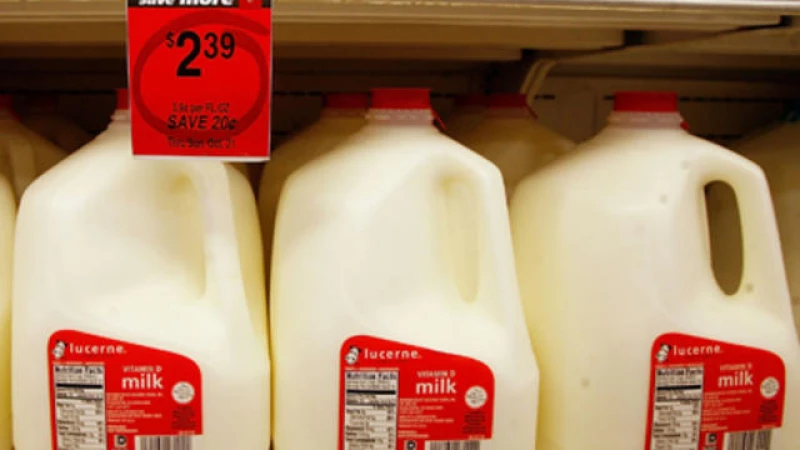The Agriculture Department is ordering the dairy industry to test milk-producing cows for infections from highly pathogenic avian influenza, or HPAI H5N1, before they're moved between states, federal officials announced Wednesday.
USDA's move to ramp up testing requirements for HPAI H5N1 comes after the Food and Drug Administration disclosed Tuesday that samples of pasteurized milk that had been sold on grocery store shelves had tested positive for the virus, prompting further research to verify if the positive test was caused by lingering dead "virus particles" or live infectious virus.
It also comes after federal authorities say they have now spotted some "isolated" but worrying changes to the virus in cows, which are believed by U.S. officials to have contracted the virus from wild birds.
"The primary focus of the order
Officials previously said that the unprecedented spread of the virus among dairy cattle likely traces to a single spillover event from wild birds, based on an analysis of genetic sequences collected from sick cattle.
Since then, genetic data and investigations suggest the virus has spread to infect cows across at least eight states and a human dairy worker in Texas. Egg farms from Texas and Michigan are also suspected to have been infected by virus that spread from cows, adding to millions of poultry culled because of infections from wild birds.
"Those farms have been in close proximity to affected dairy farms. And so there could be lateral flow from the dairy farms to these poultry operations, to these egg laying operations. This could be such things as transfer of the virus through fomites, such as on clothing or on vehicles," National Milk Producers Federation chief science officer Jamie Jonker said at recent Swine Health Information Center webinar.
The virus was not initially found in the respiratory tract of most infected cows, officials said, suggesting it is not spreading through the air between cows like other kinds of influenza. Instead, H5N1 HPAI in the current outbreak has been found almost exclusively in raw milk and the cow organs that produce it. Officials think the virus may have spread between cows during the milking process on farms, through surfaces contaminated with infected raw milk.
However, Watson said that at least one cow headed to slaughter has now been found with signs of the virus in its lung tissue. The cow was condemned by USDA inspectors and did not enter the food supply, Watson said.
Federal scientists have also found a mutation in another sick cow from Kansas that had a genetic change that adapted the flu to spread better in mammals.
"The one sequence shift and the one dairy cow with H5N1 in the lung tissue so far appear to be isolated events. However, the novel movement of H5N1 between wild birds and dairy cows requires further testing," Watson said.
Cows mostly have been recovering from the virus without dying, Watson said. That's in stark contrast to the kind of mass die-offs seen in birds and some other species. However, dairy industry officials have previously said some cows have yet to recover their ability to produce milk, raising concerns of long-term issues for some cattle.
"We need time to develop an understanding to support any future courses of action. So this federal order is critical to increasing the information available for USDA," said Watson.
H5N1 HPAI virus found in pasteurized milk
Health authorities are currently investigating the presence of H5N1 HPAI virus in pasteurized milk. While pasteurization is believed to eliminate most harmful pathogens, further studies are being conducted to confirm the safety of pasteurized milk.
The FDA's food safety center head, Don Prater, mentioned that a positive PCR test does not guarantee the presence of an intact infectious pathogen. Additional testing is necessary to determine if the virus is still viable and infectious.
To ensure the infectivity of the virus, the FDA is conducting tests using the "gold standard" method of growing H5N1 HPAI particles in chicken eggs. Additionally, research supported by the National Institutes of Health has detected H5N1 HPAI fragments in milk. Initial findings suggest that the virus in pasteurized milk may not be infectious, as attempts to grow it in cells and chicken eggs have been unsuccessful.
Dr. Jeanne Marrazzo, Director of the National Institute of Allergy and Infectious Diseases, emphasized the need for further investigation to determine the extent of the contamination in retail milk samples.
Prater mentioned that the samples were obtained from a national survey of the U.S. milk supply, but did not disclose specific details regarding where they were found and which types of milk tested positive.
"We do not have the information to share at this moment, but it will be released shortly, and that's all I can disclose for now," Prater stated.
Prater clarified that milk from cows displaying symptoms of the virus is not being introduced into the supply chain. However, there is a possibility that the virus could be entering the supply chain from other sources, such as cows that are not showing symptoms yet or have previously recovered.
According to Prater, the FDA possesses some data that could assist investigators in tracing how the virus-contaminated milk entered the food supply.
"Currently, we will be able to analyze the information we are gathering as part of this investigation. Our traceability information is reliable, though not flawless," Prater added.







